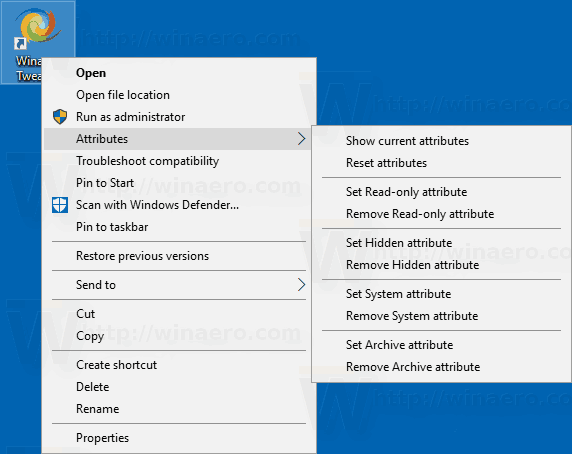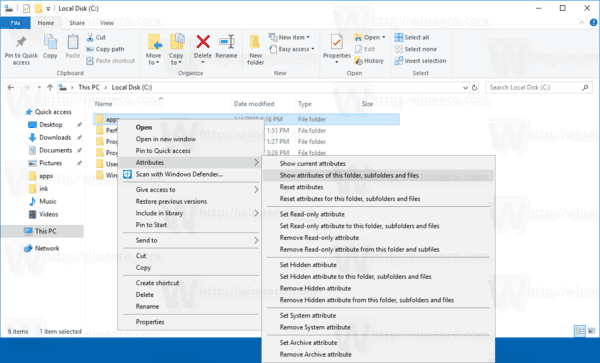File attributes are special metadata or properties of files stored in the file system which instruct computer software to change its behavior. Some of them may be enforced by operating system. For example, the read-only attribute prevents apps from writing to such files and tells File Explorer to warn the user that the file or folder can be important. The console DEL command doesn't remove files with the read-only attribute.

In my previous article, we reviewed in detail a number of methods that you can use to change attributes of a file or folder in Windows 10. If you change file attributes frequently, you might find it useful to add a special context menu.
Advertisеment
File attributes in Windows 10
Windows 10 offers the user a number of methods to change file system attributes for folders and files. Each attribute can have only one state at a moment: it can be set or disabled. While file attributes are part of file system metadata, they always considered separate from other metadata values like file date or permissions.
In Windows 10, you can use File Explorer (both the Ribbon option and the File Properties dialog), PowerShell, and the good old command prompt to modify or set file attributes. The GUI methods require many clicks, and the command prompt methods require a lot of typing. Having the context menu for file attributes will save your time and increase your productivity. Let's see how to add it.
- Download the following Registry files in a ZIP archive: Download Registry Files.
- Extract them to any folder.
- Double-click the file "Add Attributes Context Menu.reg" and confirm the operation.
- Now, right-click any file or folder. You will get the following menu.

You are done. The menu will provide the commands to set or remove the archive, hidden, system and read-only attributes with one click for both files and folders.
To get rid of the menu you added, use the provided undo tweak. Double-click the file "Remove Attributes Context Menu.reg" and you are done.
Support us
Winaero greatly relies on your support. You can help the site keep bringing you interesting and useful content and software by using these options:

Thank you, Sergey!
Please add it into your Tweaker!
OK, I’ll do.
With hold shift.
If I enable this tweak in WinAero Twaeker and then I disable it the context menu disappeared for files but not for folders.
Must be a bug. Thanks, I will check it out.
I cannot reproduce this. Here it works as expected.
I would like to suggest a change of improvement regarding the context-menus.
When a lot is added, like: Attributes, Change Owner, Inherited Permissions, and goes on(…), the list goes too long and difficult to use/find.
So, I’m trying to make a new ‘key’ in registry called (ex.) “Advanced” and include all above functions as sub-menus.
(PART of) Code examble:
[HKEY_CLASSES_ROOT\*\shell\Advanced\shell]
“HasLUAShield”=””
“MUIVerb”=”Advanced”
“SubCommands”=””
; “Extended”=”” (optional)
[HKEY_CLASSES_ROOT\*\shell\Advanced\shell\Attributes]
“MUIVerb”=”Attributes”
“SubCommands”=””
“HasLUAShield”=””
[HKEY_CLASSES_ROOT\*\shell\Advanced\shell\Attributes\shell]
[HKEY_CLASSES_ROOT\*\shell\Advanced\shell\Attributes\shell\aShow]
“MUIVerb”=”Show current attributes”
[HKEY_CLASSES_ROOT\*\shell\Advanced\shell\Attributes\shell\aShow\Command]
@=”cmd.exe /k attrib \”%1\””
…and code goes on…
I would like to suggest a change of improvement regarding the context-menus.
When a lot is added, like: Attributes, Change Owner, Inherited Permissions, and goes on(…), the list goes too long and difficult to use/find.
So, I’m trying to make a new ‘key’ in registry called (ex.) “Advanced” and include all above functions as sub-menus.
(PART of) Code examble:
[HKEY_CLASSES_ROOT\*\shell\Advanced\shell]
“HasLUAShield”=””
“MUIVerb”=”Advanced”
“SubCommands”=””
; “Extended”=”” (optional)
[HKEY_CLASSES_ROOT\*\shell\Advanced\shell\Attributes]
“MUIVerb”=”Attributes”
“SubCommands”=””
“HasLUAShield”=””
[HKEY_CLASSES_ROOT\*\shell\Advanced\shell\Attributes\shell]
[HKEY_CLASSES_ROOT\*\shell\Advanced\shell\Attributes\shell\aShow]
“MUIVerb”=”Show current attributes”
[HKEY_CLASSES_ROOT\*\shell\Advanced\shell\Attributes\shell\aShow\Command]
@=”cmd.exe /k attrib \”%1\””
…and code goes on…
I would like to suggest a change of improvement regarding the context-menus.
When a lot is added, like: Attributes, Change Owner, Inherited Permissions, and goes on(…), the list goes too long and difficult to use/find.
So, I’m trying to make a new ‘key’ in registry called (ex.) “Advanced” and include all above (‘Shield’) functions as sub-menus.
(PART of) Code examble:
[HKEY_CLASSES_ROOT\*\shell\Advanced\shell]
“HasLUAShield”=””
“MUIVerb”=”Advanced”
“SubCommands”=””
; “Extended”=”” (optional)
[HKEY_CLASSES_ROOT\*\shell\Advanced\shell\Attributes]
“MUIVerb”=”Attributes”
“SubCommands”=””
“HasLUAShield”=””
…and code goes on…
I would like to suggest a change of improvement regarding the context-menus.
When a lot is added, like: Attributes, Change Owner, Inherited Permissions, and goes on(…), the list goes too long and difficult to use/find.
So, I’m trying to make a new ‘key’ in registry called (ex.) “Advanced” and include all above functions as sub-menus.
(PART of) Code examble:
[HKEY_CLASSES_ROOT\*\shell\Advanced\shell]
“HasLUAShield”=””
“MUIVerb”=”Advanced”
“SubCommands”=””
; “Extended”=”” (optional)
[HKEY_CLASSES_ROOT\*\shell\Advanced\shell\Attributes]
“MUIVerb”=”Attributes”
“SubCommands”=””
“HasLUAShield”=””
[HKEY_CLASSES_ROOT\*\shell\Advanced\shell\Attributes\shell]
[HKEY_CLASSES_ROOT\*\shell\Advanced\shell\Attributes\shell\aShow]
“MUIVerb”=”Show current attributes”
[HKEY_CLASSES_ROOT\*\shell\Advanced\shell\Attributes\shell\aShow\Command]
@=”cmd.exe /k attrib \”%1\””
…and code goes on…
I would like to suggest a change of improvement regarding the context-menus.
When a lot is added, like: Attributes, Change Owner, Inherited Permissions, and goes on(…), the list goes too long and difficult to use/find.
So, I’m trying to make a new ‘key’ in registry called (ex.) “Advanced” and include all above (‘Shield’) functions as sub-menus.
(PART of) Code examble: (.reg)
Windows Registry Editor Version 5.00
[HKEY_CLASSES_ROOT\*\shell\Advanced\shell]
“HasLUAShield”=””
“MUIVerb”=”Advanced”
“SubCommands”=””
; “Extended”=”” (optional)
[HKEY_CLASSES_ROOT\*\shell\Advanced\shell\Attributes]
“MUIVerb”=”Attributes”
“SubCommands”=””
“HasLUAShield”=””
…and code goes on…
(PART of) Code examble: (.reg)
Windows Registry Editor Version 5.00
[HKEY_CLASSES_ROOT\*\shell\Advanced\shell]
“HasLUAShield”=””
“MUIVerb”=”Advanced”
“SubCommands”=””
; “Extended”=”” (optional)
[HKEY_CLASSES_ROOT\*\shell\Advanced\shell\Attributes]
“MUIVerb”=”Attributes”
“SubCommands”=””
“HasLUAShield”=””
…and code goes on…
(PART of) Code examble: (.reg)
Windows Registry Editor Version 5.00
[HKEY_CLASSES_ROOT\*\shell\Advanced\shell]
[HKEY_CLASSES_ROOT\*\shell\Advanced\shell\Attributes]
…and code goes on…
Windows Registry Editor Version 5.00
[HKEY_CLASSES_ROOT\*\shell\Advanced\shell]
[HKEY_CLASSES_ROOT\*\shell\Advanced\shell\Attributes]
Windows Registry Editor Version 5.00
[HKEY_CLASSES_ROOT\*\shell\Advanced\shell\Attributes] . . .